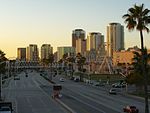Bell, California

Bell is an incorporated city in Los Angeles County, California, near the center of the former San Antonio Township (abolished after 1960). Its population was 35,477 at the 2010 census, down from 36,664 in the 2000 census. Bell is located on the west bank of the Los Angeles River and is a suburb of the city of Los Angeles. At 2.5 square miles (6.5 km2), Bell is the thirteenth-smallest city in the United States with a population of at least 25,000.In 2007, the U.S. Census Bureau ranked Bell's land area at 1245 out of 1257 cities (defined as incorporated areas) and two unincorporated areas that had a population of at least 25,000 in year 2000. Ten cities in the list of 1267 cities had no land area data (e.g., Goleta, California). City residents voted to become a charter city in a special municipal election on November 29, 2005. Fewer than 400 voters turned out for that special election. More than half of those votes were dubiously obtained absentee votes. Being a charter city meant that city officials were exempt from state salary caps. A scandal ensued, in which several city officials were indicted for giving themselves extraordinarily high salaries.
Excerpt from the Wikipedia article Bell, California (License: CC BY-SA 3.0, Authors, Images).Bell, California
East 61st Street,
Geographical coordinates (GPS) Address Nearby Places Show on map
Geographical coordinates (GPS)
| Latitude | Longitude |
|---|---|
| N 33.983333333333 ° | E -118.18333333333 ° |
Address
East 61st Street 4619
90270
California, United States
Open on Google Maps




